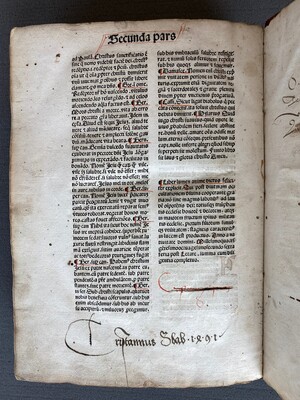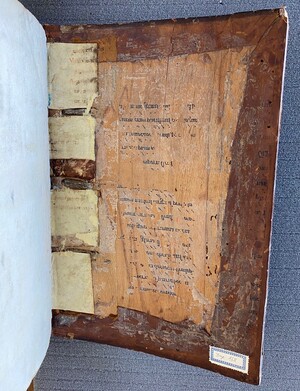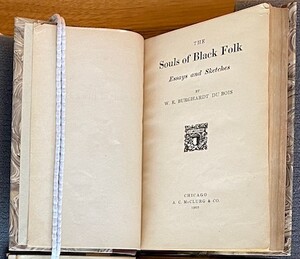
That book is really old! It even smells old.
When’s it from?
Look at its cover!
Is that leather?
How'd they make that?
These are some of the initial observations and questions students make when they visit Distinctive Collections with their classes. And it’s this type of excitement, excitement about the physical book itself, that is the beginning of students' entry into the world of rare books, discovery, and original research.
Rare Books and Manuscripts (RBM) actively strives to inspire this type of discovery. Engaging students in experiential learning—getting their hands on material objects and engaging them in critical inquiry—is one of RBM’s primary goals. To facilitate this, RBM has worked closely with faculty over the last 18 months to acquire important rare books from the earliest days of printing in the West to 21st-century contemporary artist’s books. These rare books have been acquired to be used in classes in order to provide students with opportunities to conduct original research all while learning about the physical object, proper handling of the object (to reduce the risk of accidental damage), the history of the book, and, more generally, special collections.

In late April, RBM collaborated with professors Mark Cruse (French) and Hannah Barker (History) about how to enhance RBM’s medieval holdings. After discussing the classes they teach and what types of materials would be of most interest and that could be used for students not only in their classes but other medieval courses across campus, we created a short list of themes and topics with the hope of acquiring one new rare book. We were fortunate to work with a well-respected rare books vendor to identify and acquire not just one work, but two, a 1482 printing of Berenger of Landorra’s “Lumen Animae” and a 1584 edition of “Chronicon Hierosolymitanum” compiled by Reiner Reineck (1541-95), a German humanist, that contains the accounts of the Crusades, voyages to the Middle East, and Marco Polo’s travelogue
Barker (right) and Cruse (left) are both medievalists at ASU. They are extremely excited about these new acquisitions that enhance the slim medieval holdings in Distinctive Collections. After these two books arrived arrived a few weeks ago, Barker and Cruse eagerly came in to examine the works. To their great delight, not only were the works full of juicy content, but the physical objects themselves had a lot of interesting "stuff." Provenance information, recycled manuscript waste used in the bindings, watery ink, some doodles were just some of the markings documenting the lives of these two books. Barker and Cruse are eager to investigate these works further themselves and to integrate the books into their courses. Barker and Cruse have graciously contributed to this post, each providing background about one of the texts and its significance.



Hannah Barker introduces the “Lumen animae”:
Berenger of Landorra’s “Lumen Animae” (“Light of the Soul”) was a bestseller of the fourteenth and fifteenth centuries. This encyclopedic work addresses the relationship between humanity and the natural world, gathering and reinterpreting material on both natural and moral philosophy from a wide range of authorities in Arabic, Greek, and Latin.
Taken as a whole, it reflects the emergence of a shared intellectual tradition across religious and linguistic communities in the high Middle Ages, a tradition which developed in tandem with the university as an institutionalized space for higher education. Delving into the details, the “Lumen Animae” includes fascinating entries on subjects ranging from innocence and power to geology and botany. Personally, I am interested in Berenger’s detailed explanations of how the physical environment (everything from the qualities of local water to the position of the stars at a given moment) affected the mental and physical health of individuals and their characteristics as members of various groups.

This copy of Berenger’s text is also fascinating as a historical object. It dates from 1482, squarely in the middle of a fifty-year period when printers were experimenting with new bookmaking techniques before settling on the format and layout more or less followed by printers to this day. In certain ways it still resembles a medieval manuscript, especially in its decoration and binding, but it also displays many of the characteristics associated with early printed books. I am eagerly looking forward to working with the “Lumen Animae” and bringing my students to visit it!

For the second work, Mark Cruse explains:
The compilation of works on the crusades, Islam, and the Mongols recently acquired by Hayden Library’s Distinguished Collections is one of the most remarkable books of the early modern period. Printed in 1584-1585 in Helmstadt (in modern Germany), this appears to be the oldest surviving printed edition of Albert of Aachen’s chronicle of the First Crusade, one of the most important crusade chronicles.

The book also contains four of the most valuable medieval European accounts on the Mongols: those of John of Plano Carpini (1247), Simon of Saint-Quentin (1247), Marco Polo (1298),and the Armenian Hayton (1307). This book will be a wonderful resource for all manner of research topics. I will be using it to study the ways in which Europeans imagined and represented the Mongols in the sixteenth century.

After the fall of the Yuan Empire (the Mongol empire of China) in 1368, there was little European contact with China for over 200 years. During this period, the texts in ASU’s Helmstadt volume remained essential European sources about the Far East, which became a mythical land of wealth and splendor. The dream of reaching this legendary East inspired Christopher Columbus and others to sail across the Atlantic, since the overland routes were closed.
For me, the Helmstadt volume is of the greatest historical importance for two reasons: first, it demonstrates the continuing fascination in Europe with the Mongols long after their reign had ended; and second, it also marks the end of this “medieval” fascination, because at exactly the moment it was printed, the Jesuits were settling in China and beginning a new chapter in East-West relations that would thoroughly modernize European understandings of China. I am thrilled that this book is now part of Distinguished Collections and I cannot wait to work with it.
The “Lumen animae” and “Chronicon Hierosolymitanum” are the two most recent acquisitions that further enhance RBM's recent targeted acquisitions program to support teaching and research at ASU.


Other important rare books acquired during the past 18 months include a first edition of W.E.B. DuBois’ “The Souls of Black Folk: Essays and Sketches” (1908), Theodor de Bry’s “Americae tertia pars” (1592), the 1561 Stow edition of Geoffrey Chaucer’s “The Workes of Geffrey Chaucer,” Philip Massinger ‘s “The Roman Actor” (1629), Philip Massinger and Nathan Field’s “The Fatall Dowry: A Tragedy” (1632), and Sally Ball and Jan Vicar’s “Hold” (2021).


In addition to these works, RBM has added numerous pieces to the contemporary artist’s books collection that is well used by students and faculty in the Art and Design departments and for public open houses that introduce the public to ASU’s Distinctive Collections. The bulk of these acquisitions focus on the environment and sustainability, women in science, underrepresented voices, and contemporary social issues.
All of the recent acquisitions were made with consideration given to ASU curriculum in the humanities, social sciences, and sciences to support ASU classes, to provide research opportunities for undergraduate and graduate students, and to encourage multidisciplinary work. The 1561 Chaucer was acquired in collaboration with Professor Richard Newhauser (English) and has already become the central piece for an ASU English PhD candidate’s dissertation. Working with Professor Brandi Adams (English), RBM purchased the two Massinger works, and a Barrett Honors College undergrad will write her honors thesis on Massinger’s “The Roman Actor.” With the support of the Dean of Liberal Arts and Sciences, the Piper Center for Creative Writing, the Institute for Humanities Research, the Director of the Pyracantha Press, and faculty, the artist’s book, “Hold,” was acquired and was the centerpiece of exhibit “So Much of the World Stays Beautiful,” in the Harry Wood Gallery in January-February 2022. It is also the subject of a collaborative project between Distinctive Collections, English, Design, and Sustainability Studies that will showcase student work on related themes is in the works.
Rare Books and Manuscripts has worked to establish collaborative partnerships with faculty, directors, and students at ASU and to build a rare book collection that encourages critical inquiry and original research. The acquisitions made during the past 18 months have enhanced the existing collection’s strengths and, together, these works will continue to serve the intellectual and creative endeavors of ASU students and faculty, visiting researchers, and the general public for years to come.
A note to readers:
This will be my last post as Curator of Rare Books and Manuscripts and Interim Head of Distinctive Collections for ASU Library. I extend my deepest appreciation to students, faculty, staff, researchers, visitors, and library colleagues for their enthusiasm, ideas, insights, and support. My two years at ASU have provided me with invaluable experience on which I will draw in my new position as Director of Special Collections and College Archives at Occidental College in Los Angeles.
By
Julie Tanaka
Curator of Rare Books and Manuscripts and Interim Head of Distinctive Collections
With contributions from:
Hannah Barker
Assistant Professor of History
School of Historical, Philosophical and Religious Studies
Mark Cruse
Associate Professor of French
School of International Letters and Cultures